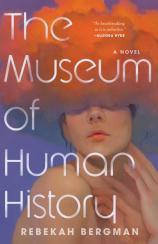The Museum of Human History
Review
The Museum of Human History
A story of memory and fantasy, THE MUSEUM OF HUMAN HISTORY juggles multiple points of view and time jumps. In her debut novel, Rebekah Bergman wields the third-person perspective fiercely; oftentimes, the book reads like first person, with intimate details and imagery within an individual’s mind. Yet she uses the wide parameters of third person, loosening the confines of dwelling in one character’s head for a prolonged period of time.
The plot --- an eight-year-old miraculously sleeps for 25 years and offers a strange hope to an amnesia-stricken city --- is told through the feelings and desires of the amnesiac citizens and the girl’s family. In its short but concise length, the novel paints a portrait of the importance of memories.
"THE MUSEUM OF HUMAN HISTORY is quite relevant in our reality of age-delaying procedures and incessant picture-taking that results in memories of screens, not of people and experiences."
A common but effective technique with time jumps is emphasizing a clear nucleus event. Unsurprisingly, the Museum of Human History is a real place in Bergman’s novel and appropriately serves as the literary HQ connecting the chapters that hop back and forth in time. The actual nucleus event is more important than its museum setting --- the ceremony for the uncanny sleeping child. In attendance are the girl’s father and sister, who are estranged; her former neighbors; her late mother’s ex-boss; the museum’s curator; and the “Congregants” who worship her.
Luke is a Congregant and the youngest person to receive the Prosyntus procedure. Around the time that Maeve Wilhelm first fell into her 25-year, age-free coma, Prosyntus was touted as a cure for getting and feeling older. But Luke and the first hordes of suddenly ageless people realized they were guinea pigs; Prosyntus induced massive long-term memory loss and was taken off the market. Some of Maeve’s visitors who reported miraculous memory recovery began viewing her as a supernatural remedy. At the celebration of Maeve’s quarter-century of sleep, Dr. Dean --- Maeve’s mother’s former boss --- knows that miracles don’t just descend from heaven in times of need.
Naomi, Maeve’s mother, was a successful but personally unfulfilled biotech exec. Key to her malaise is how she abandoned her paleontology degree after Dr. Dean offered her a lucrative biotech job. In college, Naomi researched the ancient human remains found on Marks Island; Dr. Dean’s interest was piqued, particularly with her insights into prehistoric algae. He offered her a position to return to Marks Island and continue her research, but she wasn’t allowed to ask questions. When Naomi noticed that the rare algae suddenly returned to Marks Island, she couldn’t help but wonder what really piqued her boss and company’s interest. Unbeknownst to Naomi, her twin daughters, Maeve and Evangeline, liked playing by the beach. Poor Maeve was tricked by neighborhood kids into eating the algae.
Naomi’s research on the island resulted in Prosyntus. Though the procedure made aging and pain a thing of the past, death was the same inevitability, like it was for the ancient humans she studied. Luke’s wife, Tess, embodied this shortcoming of Prosyntus. Despite being a young newlywed, Tess developed terminal cancer; looking and feeling young wouldn’t have done much to stop her body from destroying itself. After her passing, Luke decided to undergo Prosyntus to preserve both her and who he was when he was her husband. Cruelly and ironically, it wiped him clean of any memory of Tess.
Also wrestling with Prosyntus were Sylvia and Abe, new parents who were 23 years apart. Abe, the older partner, wanted Prosyntus to stop his ailments and the age gap from looking wider, but Sylvia wasn’t as sold on the idea. She worried that Prosyntus would make his present too palpable and perpetual, weakening their ability to remember the past. Though she acknowledged that she couldn’t fully relate to his ailments, she viewed age as a vessel for memory. Like a mustache that was more stylish in decades past, or a wrinkle that once had not been present, aging and its signs can be a way to recall events and people.
But the algae’s fantastical and uncontrollable properties soon caught up with Prosyntus supporters and with Maeve. During a day at the pool, Maeve’s neighborhood blissfully failed to notice her absence --- that is, until she was found at the bottom of the water. Though she became brain dead, Maeve’s breathing never stopped. Her father, Lionel, opted to keep her alive and care for her at home, a painful reminder for her twin sister.
Besides doctors, one of Maeve’s visitors had dementia (which was unrelated to Prosyntus), and she suddenly remembered again after being in her presence. Victims of Prosyntus, like Luke, soon made their own efforts to regain their memories. The inexplicable memory recovery blended with a strange but beautiful display when moths in Maeve’s room seemingly arranged in an M, convincing people that Maeve was some kind of savior and a protector from the aging “cure.”
Events within Maeve’s 25-year sleep culminate in her ceremony inside the Museum of Human History. Many of Bergman’s characters display fears of forgetting and make efforts to remember, like planting mental seeds for future recollection. They also are concerned about insignificance in a universe that might as well be permanent. By the end of the book, they illustrate hopeful themes of age and memory. THE MUSEUM OF HUMAN HISTORY is quite relevant in our reality of age-delaying procedures and incessant picture-taking that results in memories of screens, not of people and experiences.
Reviewed by Sam Johnson on August 18, 2023
The Museum of Human History
- Publication Date: August 1, 2023
- Genres: Fiction, Magical Realism
- Paperback: 256 pages
- Publisher: Tin House Books
- ISBN-10: 1953534910
- ISBN-13: 9781953534910




